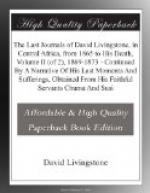5th March, 1873.—Time runs on quickly. The real name of this island is Masumbo, and the position may be probably long. 31 deg. 3’; lat. 10 deg. 11’ S. Men not arrived yet. Matipa very slow.
6th March, 1873.—Building a camp outside the town for quiet and cleanliness, and no mice to run over us at night. This islet is some twenty or thirty feet above the general flat country and adjacent water.
At 3 P.M. we moved up to the highest part of the island where we can see around us and have the fresh breeze from the Lake. Rainy as we went up, as usual.
7th March, 1873.—We expect our men to-day. I tremble for the donkey! Camp sweet and clean, but it, too, has mosquitoes, from which a curtain protects me completely—a great luxury, but unknown to the Arabs, to whom I have spoken about it. Abed was overjoyed by one I made for him; others are used to their bites, as was the man who said that he would get used to a nail through the heel of his shoe. The men came at 3 P.M., but eight had to remain, the canoes being too small. The donkey had to be tied down, as he rolled about on his legs and would have forced his way out. He bit Mabruki Speke’s lame hand, and came in stiff from lying tied all day. We had him shampooed all over, but he could not eat dura—he feels sore. Susi did well under the circumstances, and we had plenty of flour ready for all. Chanza is near Kabinga, and this last chief is coming to visit me in a day or two.
8th March, 1873.—I press Matipa to get a fleet of canoes equal to our number, but he complains of their being stolen by rebel subjects. He tells me his brother Kabinga would have been here some days ago but for having lost a son, who was killed by an elephant: he is mourning for him but will come soon. Kabinga is on the other side of the Chambeze. A party of male and female drummers and dancers is sure to turn up at every village; the first here had a leader that used such violent antics perspiration ran off his whole frame. I gave a few strings of beads, and the performance is repeated to-day by another lot, but I rebel and allow them to dance unheeded. We got a sheep for a wonder for a doti; fowls and fish alone could be bought, but Kabinga has plenty of cattle.
[Illustration: Dr. Livingstone’s Mosquito Curtain.]
There is a species of carp with red ventral fin, which is caught and used in very large quantities: it is called “pumbo.” The people dry it over fires as preserved provisions. Sampa is the largest fish in the Lake, it is caught by a hook. The Luena goes into Bangweolo at Molandangao. A male Msobe had faint white stripes across the back and one well-marked yellow stripe along the spine. The hip had a few faint white spots, which showed by having longer hair than the rest; a kid of the same species had a white belly.
The eight men came from Motovinza this afternoon, and now all our party is united. The donkey shows many sores inflicted by the careless people, who think that force alone can be used to inferior animals.




